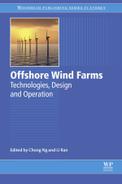Modelling of power electronic components for evaluation of efficiency, power density and power-to-mass ratio of offshore wind power converters
Abstract
In an offshore environment, the efficiency (η), power density (ρ) and the power-to-mass ratio (γ) are performance indices of paramount importance in the design of the wind energy conversion systems in order to reduce investment costs, especially when most of the electrical conversion components are going to be located in the nacelle or tower of the wind turbine. This chapter describes a simple procedure to calculate the η, the ρ and the γ of power converters for offshore wind turbines via the calculation of power losses, volume and mass of the main components of the wind energy conversion systems (WECS): the power electronics valves, the magnetics components and the capacitors. A base topology known as the two-level voltage source converter (2L-VSC) has been considered in order to illustrate the evaluation procedure.
Keywords
Design methodology; Efficiency; Mass; Power density; Power electronics converter; Power losses; Power-to-mass ratio; Volume; Wind power generation9.1. Introduction
![]() [9.1]
[9.1]
 [9.2]
[9.2]
![]() [9.3]
[9.3]
